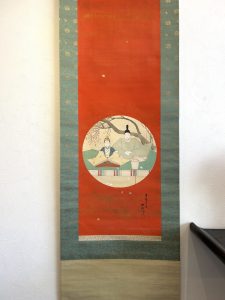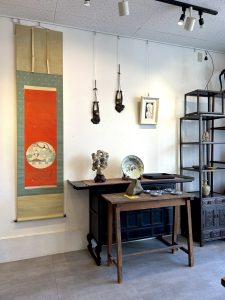春の訪れを気長に待ちます(愛知県名古屋市千種区姫池通 骨董買取 古美術風光舎)
2024.02.04
皆さまこんにちは。スタッフHでございます。
本日は立春。暦の上では春の始まりを告げる日となっております。まだまだ寒い日が続きますが、立春ですよと言われると気持ちが少し和らぐ気がいたします。
店内に掛けられた節句の掛軸にも春の訪れを感じます。
部屋の模様替えとして、敷物やクッションなどの布物を変えると季節感を演出できるといわれますが、掛軸を季節や行事ごとに掛け替えるのも簡単で効果的な方法かもしれません。
床の間がないと飾れないのではと思い込んでいましたが、絵やタペストリーのように気軽に楽しめるものなのかもと思えてきました。
掛軸とは縁のない生活をしておりましたが、触れる機会が多くなり興味が湧いてまいりました。
掛軸は中国から伝来したもので、元は仏教画を掛けて拝する礼拝の対象として生まれたということです。丸めて持ち運びやすく、桐箱に入れることで汚れが付きにくく劣化を防ぐことができ、仏教の普及に役立ったとのこと。
現在の掛軸の様式が確立されたのは唐の時代で、日本へは飛鳥時代に仏教と共に伝わってきたとされています。その後、鎌倉時代に禅宗の影響で水墨画が流行ると、それに伴い掛軸も広まり、室町時代には茶道の流行と共に茶室の床の間を飾ることを目的とした鑑賞用の水墨画などの掛軸がたくさん作られるようになりました。
先日、日本の諸芸道における「真・行・草」の概念について触れましたが、掛軸の表装においてもこの概念が適用されるようです。一般的には茶室で飾られる掛軸は「草」とされています。
また「風帯(ふうたい)」と呼ばれる表具の上から垂れ下がっている2本の細い布がある掛軸の方が格が高いとされています。このひらひらしたもの、何のためにあるのか不思議に思っておりましたので調べてみました。
昔の中国では掛軸は軒先や屋外に近い広間に飾られることがありました。そのため鳥に汚される恐れがあり、風帯が風になびくことで鳥除けとなっていたようです。そのため「驚燕(きょうえん)」とも呼ばれていたとか。実用的な目的があったのですね。中国では明の時代に廃れ、日本では単に装飾するものとして形式だけが残ったといわれています。
しかし風帯の作成は高度な裁縫技術が必要で、かなりの手間もかかるといいます。それでも残していったのは「ある方がいいよね」という日本人の美的感覚もあったのではないかと勝手に推測しています。個人的には風帯があると少し立体感が出るような気がします。
これまで掛軸の絵や文字にしか意識が向いておりませんでしたが、こちらの桃の節句の掛軸を眺めていますと、表装とのトータルコーディネートの大切さ、面白さも感じます。
こちらの掛軸を眺めながら春を気長に待ちたいと思います。
それでは、また次の機会に。

Hello everyone. This is Staff H.
Today is the first day of spring. According to the calendar, it marks the beginning of spring. Although the days are still cold, I feel a little more relaxed when I am told that it is Risshun.
The hanging scrolls of seasonal festivals in our store also remind us of the coming of spring.
It is said that changing the fabric of a room, such as rugs and cushions, can create a sense of the season, but changing the hanging scrolls for each season and event may be an easy and effective way to change the look of a room.
I used to think that you need to have an alcove to display them, but now I am beginning to think that they can be enjoyed as casually as paintings or tapestries.
I have never been involved with hanging scrolls in my life, but now that I have more opportunities to come into contact with them, I have become more interested in them.
Kakejiku scrolls were introduced from China, and were originally created as objects of worship to be hung and worshipped with Buddhist paintings. They were rolled up for easy transportation and placed in paulownia wood boxes to prevent them from getting dirty and deteriorating, thus helping to spread Buddhism.
The current style of hanging scrolls was established in the Tang Dynasty, and it is said that they were introduced to Japan along with Buddhism in the Asuka Period. Later, when ink and wash painting became popular under the influence of Zen Buddhism in the Kamakura period (1185-1333), hanging scrolls spread along with it, and in the Muromachi period (1333-1573), with the popularity of the tea ceremony, many hanging scrolls with ink and wash paintings for appreciation were produced to decorate alcoves in tea rooms.
The other day, I mentioned the concept of “truth, action, and grass” in the various Japanese arts, and it seems that this concept also applies to the mounting of kakejiku. Generally, kakejiku displayed in a tea ceremony room are considered to be “grass.
A kakejiku with two thin strips of cloth called “fūtai” hanging down from the top of the mounting is considered to be more prestigious. I wondered what this fluttering cloth was for, so I looked it up.
In old China, hanging scrolls were often displayed at the eaves or in a hall near the outdoors. Therefore, there was a fear that they might be soiled by birds, and it seems that the wind band fluttering in the wind served as a bird repellant. That is why it was also called “kyoyen,” meaning “surprised swallow. So it had a practical purpose. In China, it was abandoned during the Ming dynasty (1368-1644), and in Japan, it is said that only the form remained as a mere decoration.
However, it is said that creating a futai requires advanced sewing techniques and a great deal of time and effort. I assume that the reason why they still kept them was due to the aesthetic sense of the Japanese people, who thought that it was better to have them. Personally, I feel that the wind belt gives a slightly more three-dimensional effect.
I have only been conscious of the pictures and words on the hanging scrolls, but looking at this Momo-no-Sekku hanging scroll, I feel the importance and interest of total coordination with the mounting.
I would like to wait patiently for spring while looking at this hanging scroll.
See you next time.
*******************
ご実家の整理やお片付けなどをされている方のご相談などが多くございます。
お片付けなどくれぐれもご無理のないようになさってくださいませ。
風光舎では古美術品や骨董品の他にも絵画や宝石、趣味のお品など様々なジャンルのものを買受しております。
お片付けをされていて、こういうものでもいいのかしらと迷われているものでも、どうぞお気軽にご相談下さいませ。
また風光舎は、出張買取も強化しております。ご近所はもちろん、愛知県内、岐阜県、三重県その他の県へも出張いたします。
まずは、お電話お待ちしております。
愛知県名古屋市千種区姫池通
骨董 買取【古美術 風光舎 名古屋店】
TEL052(734)8444
10:00-18:00 OPEN
#骨董買取#古美術買取#出張買取#無料査定#生前整理#遺品整理#家じまい#実感じまい#掛け軸#絵画#木箱入り茶碗#刀剣#洋食器#貴金属


